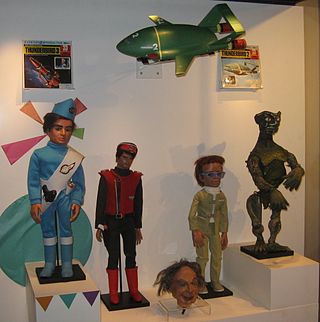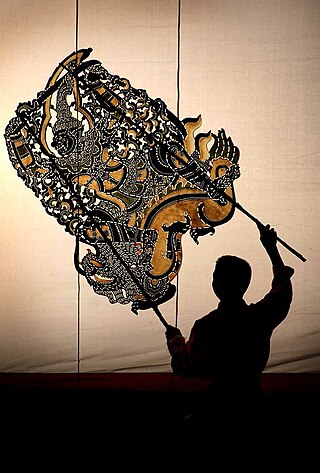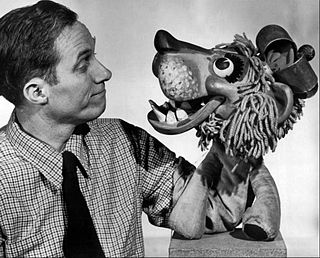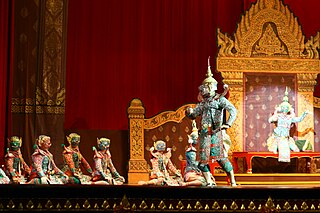
Supermarionation is a style of television and film production employed by British company AP Films in its puppet TV series and feature films of the 1960s. These productions were created by Gerry and Sylvia Anderson and filmed at APF's studios on the Slough Trading Estate. The characters were played by electronic marionettes with a moveable lower lip, which opened and closed in time with pre-recorded dialogue by means of a solenoid in the puppet's head or chest. The productions were mostly science fiction with the puppetry supervised by Christine Glanville, art direction by either Bob Bell or Keith Wilson, and music composed by Barry Gray. They also made extensive use of scale model special effects, directed by Derek Meddings.

Puppetry is a form of theatre or performance that involves the manipulation of puppets – inanimate objects, often resembling some type of human or animal figure, that are animated or manipulated by a human called a puppeteer. Such a performance is also known as a puppet production. The script for a puppet production is called a puppet play. Puppeteers use movements from hands and arms to control devices such as rods or strings to move the body, head, limbs, and in some cases the mouth and eyes of the puppet. The puppeteer sometimes speaks in the voice of the character of the puppet, while at other times they perform to a recorded soundtrack.

A marionette is a puppet controlled from above using wires or strings depending on regional variations. A marionette's puppeteer is called a marionettist. Marionettes are operated with the puppeteer hidden or revealed to an audience by using a vertical or horizontal control bar in different forms of theatres or entertainment venues. They have also been used in films and on television. The attachment of the strings varies according to its character or purpose.

A sock puppet, sockpuppet, sock-puppet, or sock poppet is a puppet made from a sock or a similar garment. The puppeteer wears the sock on a hand and lower arm as if it were a glove, with the puppet's mouth being formed by the region between the sock's heel and toe, and the puppeteer's thumb acting as the jaw. The arrangement of the fingers forms the shape of a mouth, which is sometimes padded with a hard piece of felt, often with a tongue glued inside.

Bunraku is a form of traditional Japanese puppet theatre, founded in Osaka in the beginning of the 17th century, which is still performed in the modern day. Three kinds of performers take part in a bunraku performance: the Ningyōtsukai or Ningyōzukai (puppeteers), the tayū (chanters), and shamisen musicians. Occasionally other instruments such as taiko drums will be used. The combination of chanting and shamisen playing is called jōruri and the Japanese word for puppet is ningyō. It is used in many plays.

Nang yai is a form of shadow play found in Thailand. Puppets are made of painted buffalo hide, while the story is narrated by songs, chants and music.

Shadow play, also known as shadow puppetry, is an ancient form of storytelling and entertainment which uses flat articulated cut-out figures which are held between a source of light and a translucent screen or scrim. The cut-out shapes of the puppets sometimes include translucent color or other types of detailing. Various effects can be achieved by moving both the puppets and the light source. A skilled puppeteer can make the figures appear to walk, dance, fight, nod and laugh.

A hand puppet is a type of puppet that is controlled by the hands that occupies the interior of the puppet. A glove puppet is a variation of hand puppets. Rod puppets require one of the puppeteer's hands inside the puppet glove holding a rod which controls the head, and the puppet's body then hangs over most or all of the forearm of the puppeteer, and possibly extends further. Other parts of the puppet may be controlled by different means, e.g., by rods operated by the puppeteer's free hand, or strings or levers pulled the head or body. A smaller variety, simple hand puppets often have no significant manipulable parts at all. Finger puppets are not hand puppets as they are used only on a finger.
Digital puppetry is the manipulation and performance of digitally animated 2D or 3D figures and objects in a virtual environment that are rendered in real-time by computers. It is most commonly used in filmmaking and television production but has also been used in interactive theme park attractions and live theatre.

Ancient Siam is a museum park constructed by Lek Viriyaphant and occupying over 200 acres (0.81 km2) in the shape of Thailand.
Sakorn Yang-keawsot was a Thai puppeteer. He was a master of the hun lakorn lek. Also known by his English nickname, Joe Louis, in 1965 he founded the Sakorn Hunlakornlek troupe with his daughter, Thitawan Yangkheiosod. Later, in 2001, his son, Pisutr Yang-keawsot formed a new troupe named Joe Louis and founded Joe Louis Puppet Theatre under his acknowledgment. He was named a National Artist for performing arts in 1996.
The Joe Louis Puppet Theatre or Nattayasala Hun Lakhon Lek, is the traditional Thai Hun Lakorn Lek marionette show originating in 1898, which was modeled from the Siamese court puppetries aged 1782 CE with the Chinese Glove puppetry influence at the Front Palace of Siamese Prince Wichaichan. It was first founded in 1985 under the name Sakorn Natasilp by Sakorn Yang-keawsot, later the Joe Louis Puppet Theatre, and publicly performed by request of the Tourism Authority of Thailand (TAT). Later, the Joe Louis Puppet Theatre bestowed the official name as the Nattayasala Hun Lakhon Lek theatre and was patronized by Princess Galyani Vadhana.

Khon is a dance drama genre from Thailand. Khon has been performed since the Ayutthaya Kingdom.
Yen Kaewmanee or Pu Yen, was a famous centenarian who lived to an age of 108. The Thai Muslim man was known for his self-sufficient and economical way of living. His lifestyle embodied King Bhumibol Adulyadej's philosophy on self-sufficiency. The elderly man made his living fishing from the Phetchaburi River in Phetchaburi, Thailand. He sold the fish to locals at inexpensive prices in exchange for other necessities. For many years until his death, he refused offers of free food, preferring to live in his small boat.

A puppet is an object, often resembling a human, animal or mythical figure, that is animated or manipulated by a person called a puppeteer. Puppetry is an ancient form of theatre which dates back to the 5th century BC in ancient Greece.

The Opera dei Pupi is a marionette theatrical representation of Frankish romantic poems traditionally performed in Sicily, Italy.

Baltal is a form of puppet theatre from Korea. It is one of Korea's Important Intangible Cultural Properties.

Water puppetry is a Vietnamese tradition that dates back as far as the 11th century, when it originated in the villages of the Red River Delta, in the north of the country. Vietnamese water puppetry is a variation on the ancient Asian puppet tradition.

Lakhon chatri is a genre of dance-drama from Central Thailand and is closely related to the Nora of Southern Thailand. The word "chatri" has been derived from Sanskrit "kshatriya" which means a member of the Hindu royal and warrior class above Vaisyas and below the Brahmans. Lakhon Chatri presents the story of the kings.
Waldo Sullivan Lanchester was a British puppeteer who founded the Lanchester Marionettes (1935–1962), a puppet theatre that was based in Malvern, and later in Stratford-upon-Avon. He wrote a book on the revival of puppeteering and commissioned George Bernard Shaw to write his last completed play Shakes versus Shav in 1949. In 1952, Donald W. Seager wrote that "Waldo Lanchester has consistently been associated with all that is best in the puppet theatre." Archibald Henderson called him "England's greatest puppetmaster."















